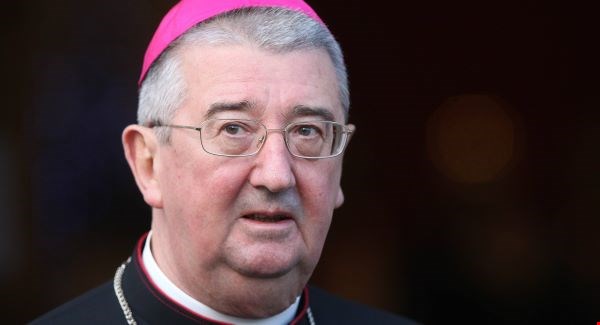The eventual successor to Archbishop Diarmuid Martin faces many immediate challenges writes Michael Kelly
In an era of flourishing faith, plentiful vocations and widespread esteem for the Church, being a bishop in Ireland was an attractive prospect for any ambitious cleric. It used to be said that when a priest was elevated to the Episcopate two things would happen: he would never eat another bad meal again and he’d never again be told the truth.
Fast forward to 2018 and now the gallows humour in clerical circles holds that anyone who wants to become a bishop deserves it. At a time when respect for the Church is not what it was and vocations are as rare as hens’ teeth, the Pope’s man in Dublin, Papal Nuncio Archbishop Jude Okolo, has his work cut out to select the men that will lead the Church in the capital in the next decades.
If it were ever the case that bishops in bygone eras were shielded from the truth, they certainly aren’t now. One of the most pressing tasks facing any new bishop is meeting seemingly endless pastoral commitments with fewer and fewer priests.
While Achonry, Clonfert, Clogher, Dromore and Cork & Ross are awaiting new bishops, eyes are increasingly focused on succession in the sprawling Archdiocese of Dublin.
Archbishop Diarmuid Martin’s hint, even before the World Meeting of Families, that he may well step down before he is due to in April 2020 has turned attention towards his potential successor. The Papal visit – interpreted by many as an underwhelming experience – has shone a light on the Church in Dublin and the depth of the crisis.
It’s a challenging diocese. Dr Martin has been criticised by some for being too pessimistic. People mightn’t like that he frequently references the fact that Mass attendance in some parishes is as low as 2%, but he’s not making the figure up. The numeric challenges facing his successor are real. While attendance in middle-class areas is relatively stable, it has collapsed in many working-class communities.
Indications
Some years ago, the Dublin Council of Priests sponsored a survey by an independent firm of actuaries, based on current statistical information, that looked at numbers of priests and at indications about the size of future congregations in the year 2030.
The best-case scenario predicted a decline in priest numbers of 61%, from 369 priests down to 144 in 2030, provided religious orders maintain their current level of commitment in parishes in the diocese
If religious orders were to relinquish the parishes they currently serve, due to the age profile of their own priests, the drop by 2030 would be 70% leaving just 111 priests carrying out parish ministry across Dublin’s 199 parishes. Almost 60% of the priests currently serving in Dublin are over 60 years of age and this is projected to increase to 75% by 2030; the findings predict that just one new priest under the age of 40 will join the priesthood in Dublin every year up to 2030.
Other research findings include a predicted drop in Mass attendances in Dublin by 33% by 2030.
Despite this, Archbishop Martin – who is notoriously prickly and thin-skinned about criticism – has not moved to take any radical action across the diocese. He has stretched priests thinner, appointing many to serve multiple parishes. He has also appointed lay pastoral workers with varying degrees of success. The permanent diaconate is growing as a ministry, but a lot of priests are sceptical.
In terms of the future of the diocese, there is little consensus amongst the priests except that a change would be no bad thing. Most Dublin priests are fair to Archbishop Martin when asked. They generally extol his virtues including the fact that he is widely-liked by parishioners and the fact that his decisive handling of clerical sexual abuse has gone some way to restore credibility in the Church.
But, they also speak of feeling unsupported, of a sense that the archbishop is not as available to them as they think he should be. Some priests speak of letters about important subjects going unanswered. Others grumble about a lack of appetite about making tough decisions. Overall, with a few exceptions, there is a sense that there is somewhat of a chasm between Dr Martin and the priests of the archdiocese.
So, what of potential successors? The nuncio is charged with preparing a list of three candidates for Pope Francis. Sources believe that the powerful head of the Vatican’s Congregation for Bishops Canadian Cardinal Marc Ouellet will have a huge say in the succession. He knows Dublin from his role as Papal legate to the 2012 Eucharistic Congress.
*****
The first name that invariably comes to mind amongst priests is the Rome-based Bishop Paul Tighe. A priest of Dublin, the 60-year old has been in the eternal city for more than a decade serving in the Roman Curia. Before being sent to Rome in 2007, he served as Director of Public Affairs for Dr Martin and is a close confidant of the archbishop’s.
Bishop Tighe is seen as a competent administrator whose vision of the Church would be seen as in the same mould as Diarmuid Martin’s.
He would be seen as an accommodationist rather than confrontational in his approach to the Church’s role in the public sphere. His first pastoral appointment was to the Dublin suburb of Ballyfermot and he later taught moral theology at the now defunct Mater Dei Institute of Education. Contemporaries and former students describe him as approachable and friendly. Though, one former colleague questioned whether he had the breadth of vision the diocese needs.
Currently secretary of the Pontifical Council for Culture, Bishop Tighe would be seen as Archbishop Martin’s chosen successor and knows the diocese inside out.
Another name that comes up is that of Bishop of Limerick Brendan Leahy. A native of Dublin, 58-year-old Dr Leahy is a qualified barrister and known for his association with the Focolare lay movement.
He has been Bishop of Limerick since 2013 where locals say he has excelled at pastoral outreach. He is credited with a collaborative style of leadership and won praise for his initiatives to involve more laypeople in the running of the Church.
He pioneered a diocesan synod in Limerick and has faced challenges like the declining number of clergy head on. He has just launched a new programme based on team ministry where priests will work in pastoral units where teams of clergy will minister in each unit but existing parish identity will be preserved.
Interventions
Bishop Kevin Doran of Elphin is another former Dublin priest who is spoken about by some clergy. His high-profile interventions in referenda on same-sex marriage and abortion were in stark contrast to Dr Martin’s more reserved style.
He is pastoral and approachable and combines a keen intellect with humility.
His outspoken nature might rule him out for Dublin. One priest friend describes Dr Doran as “not lacking courage, but perhaps lacking caution”.
But, then again, caution is not exactly a Christian virtue.
Some priests who spoke to The Irish Catholic speak well of Bishop Denis Nulty of Kildare and Leighlin. He is seen as a pastoral bishop who is not afraid to get his hands dirty – what Pope Francis might describe as having “the smell of the sheep”. Fifty-five-year-old Dr Nulty has served as a member of the bishops’ conference for over five years now and is regarded as a good leader. He has moved to include parishioners more in the decision-making process in Kildare and Leighlin and recently announced plans for a new diocesan-wide pastoral council.
Another name in the mix is Capuchin provincial Fr Adrian Curran. Some priests who spoke to The Irish Catholic believe the appointment of someone like Fr Curran, a priest not of the diocese but serving in Dublin, could bring much-needed perspective to the task of leading Dublin in the future. Fr Curran is well-respected both within his Capuchin order and in wider Church circles. At a time when homelessness is on the rise in the capital, his order is amongst the most well-known when it comes to the Church’s social action.
Whoever Pope Francis appoints to Dublin will have an immediate job of work to reorganise the diocese to cope with the declining number of priests.
He will also have the job of selling off a lot of the Church’s infrastructure. He will have assistance in this given the fact that Dr Martin has recently invested in training priests to deal with what Church law describes as the alienation of temporal goods.
Above all, the next Archbishop of Dublin will have to articulate a vision of the Church that will lift priestly morale and excite jaded congregations anew about the joy of the Gospel.


 Michael Kelly
Michael Kelly Archbishop Diarmuid Martin
Archbishop Diarmuid Martin 